The Economic Effects of Minimum Wage Policies in the UK
VerifiedAdded on 2023/01/12
|8
|2428
|42
Essay
AI Summary
This essay provides an economic analysis of the minimum wage in the UK, examining its impact on employment, poverty, and the overall economy. It begins by defining minimum wage and its purpose, highlighting its role in protecting workers and addressing inequalities. The main body delves into the current minimum wage rates, the distinction between minimum wage and collective bargaining, and the effects of wage increases on both the supply and demand sides of the labor market. The essay discusses the potential benefits, such as poverty reduction and increased worker motivation, as well as the potential drawbacks, including job losses and inflation. It references various studies and economic theories to support its arguments, including the effects of the minimum wage on unemployment, cost-push inflation, and aggregate demand. The conclusion summarizes the findings, emphasizing the government's role in setting and analyzing the minimum wage to address labor market issues and poverty.
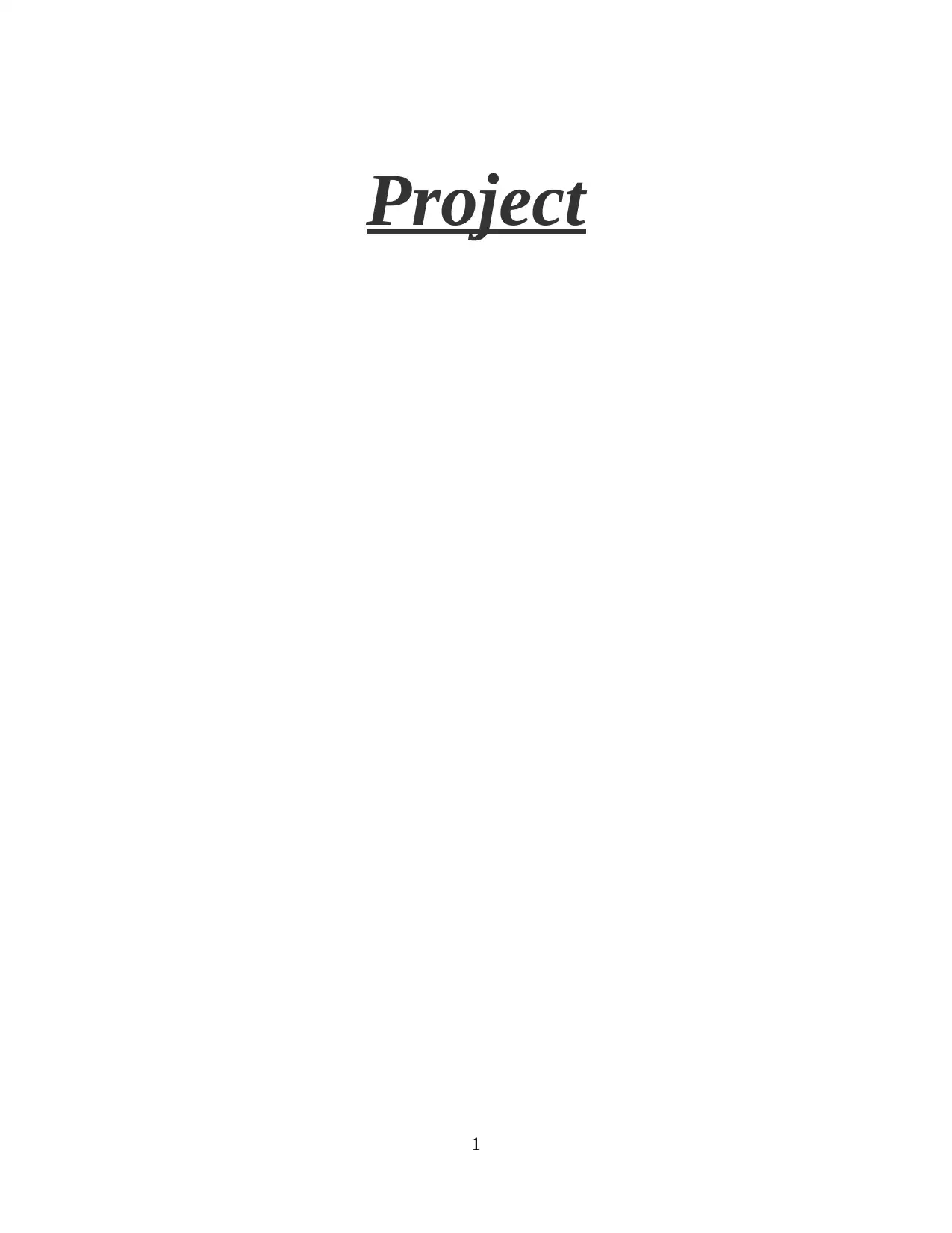
Project
1
1
Paraphrase This Document
Need a fresh take? Get an instant paraphrase of this document with our AI Paraphraser
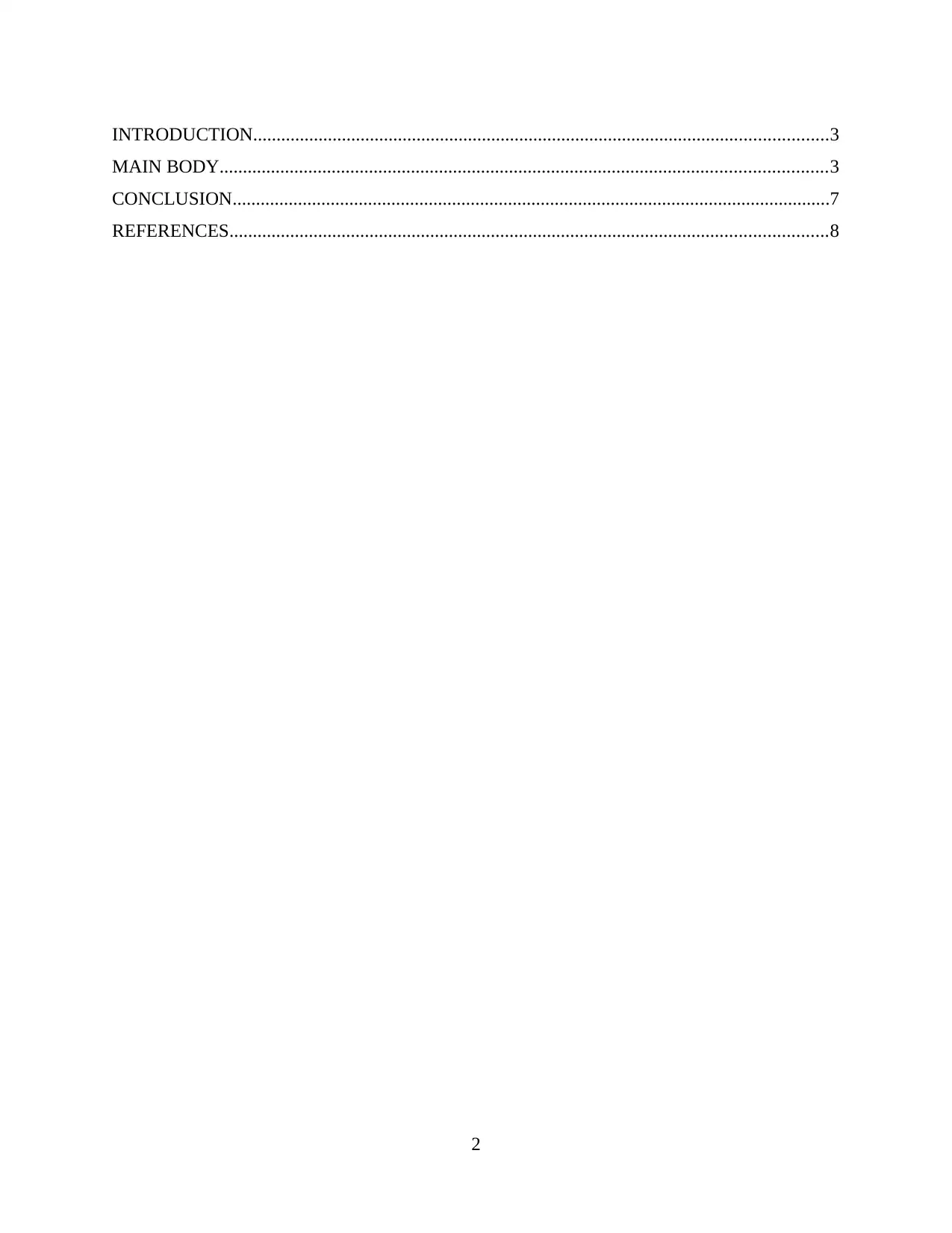
INTRODUCTION...........................................................................................................................3
MAIN BODY..................................................................................................................................3
CONCLUSION................................................................................................................................7
REFERENCES................................................................................................................................8
2
MAIN BODY..................................................................................................................................3
CONCLUSION................................................................................................................................7
REFERENCES................................................................................................................................8
2
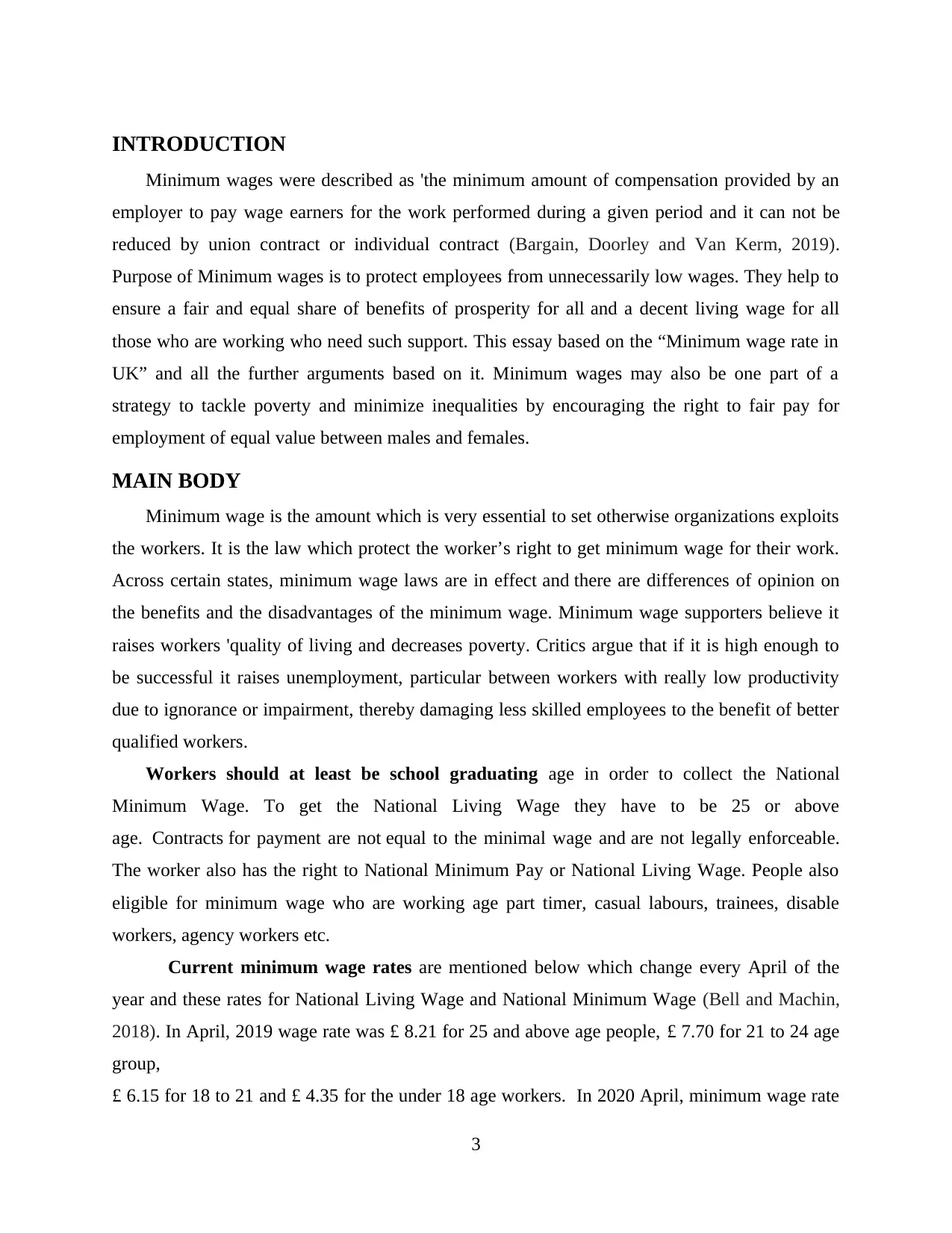
INTRODUCTION
Minimum wages were described as 'the minimum amount of compensation provided by an
employer to pay wage earners for the work performed during a given period and it can not be
reduced by union contract or individual contract (Bargain, Doorley and Van Kerm, 2019).
Purpose of Minimum wages is to protect employees from unnecessarily low wages. They help to
ensure a fair and equal share of benefits of prosperity for all and a decent living wage for all
those who are working who need such support. This essay based on the “Minimum wage rate in
UK” and all the further arguments based on it. Minimum wages may also be one part of a
strategy to tackle poverty and minimize inequalities by encouraging the right to fair pay for
employment of equal value between males and females.
MAIN BODY
Minimum wage is the amount which is very essential to set otherwise organizations exploits
the workers. It is the law which protect the worker’s right to get minimum wage for their work.
Across certain states, minimum wage laws are in effect and there are differences of opinion on
the benefits and the disadvantages of the minimum wage. Minimum wage supporters believe it
raises workers 'quality of living and decreases poverty. Critics argue that if it is high enough to
be successful it raises unemployment, particular between workers with really low productivity
due to ignorance or impairment, thereby damaging less skilled employees to the benefit of better
qualified workers.
Workers should at least be school graduating age in order to collect the National
Minimum Wage. To get the National Living Wage they have to be 25 or above
age. Contracts for payment are not equal to the minimal wage and are not legally enforceable.
The worker also has the right to National Minimum Pay or National Living Wage. People also
eligible for minimum wage who are working age part timer, casual labours, trainees, disable
workers, agency workers etc.
Current minimum wage rates are mentioned below which change every April of the
year and these rates for National Living Wage and National Minimum Wage (Bell and Machin,
2018). In April, 2019 wage rate was £ 8.21 for 25 and above age people, £ 7.70 for 21 to 24 age
group,
£ 6.15 for 18 to 21 and £ 4.35 for the under 18 age workers. In 2020 April, minimum wage rate
3
Minimum wages were described as 'the minimum amount of compensation provided by an
employer to pay wage earners for the work performed during a given period and it can not be
reduced by union contract or individual contract (Bargain, Doorley and Van Kerm, 2019).
Purpose of Minimum wages is to protect employees from unnecessarily low wages. They help to
ensure a fair and equal share of benefits of prosperity for all and a decent living wage for all
those who are working who need such support. This essay based on the “Minimum wage rate in
UK” and all the further arguments based on it. Minimum wages may also be one part of a
strategy to tackle poverty and minimize inequalities by encouraging the right to fair pay for
employment of equal value between males and females.
MAIN BODY
Minimum wage is the amount which is very essential to set otherwise organizations exploits
the workers. It is the law which protect the worker’s right to get minimum wage for their work.
Across certain states, minimum wage laws are in effect and there are differences of opinion on
the benefits and the disadvantages of the minimum wage. Minimum wage supporters believe it
raises workers 'quality of living and decreases poverty. Critics argue that if it is high enough to
be successful it raises unemployment, particular between workers with really low productivity
due to ignorance or impairment, thereby damaging less skilled employees to the benefit of better
qualified workers.
Workers should at least be school graduating age in order to collect the National
Minimum Wage. To get the National Living Wage they have to be 25 or above
age. Contracts for payment are not equal to the minimal wage and are not legally enforceable.
The worker also has the right to National Minimum Pay or National Living Wage. People also
eligible for minimum wage who are working age part timer, casual labours, trainees, disable
workers, agency workers etc.
Current minimum wage rates are mentioned below which change every April of the
year and these rates for National Living Wage and National Minimum Wage (Bell and Machin,
2018). In April, 2019 wage rate was £ 8.21 for 25 and above age people, £ 7.70 for 21 to 24 age
group,
£ 6.15 for 18 to 21 and £ 4.35 for the under 18 age workers. In 2020 April, minimum wage rate
3
⊘ This is a preview!⊘
Do you want full access?
Subscribe today to unlock all pages.

Trusted by 1+ million students worldwide
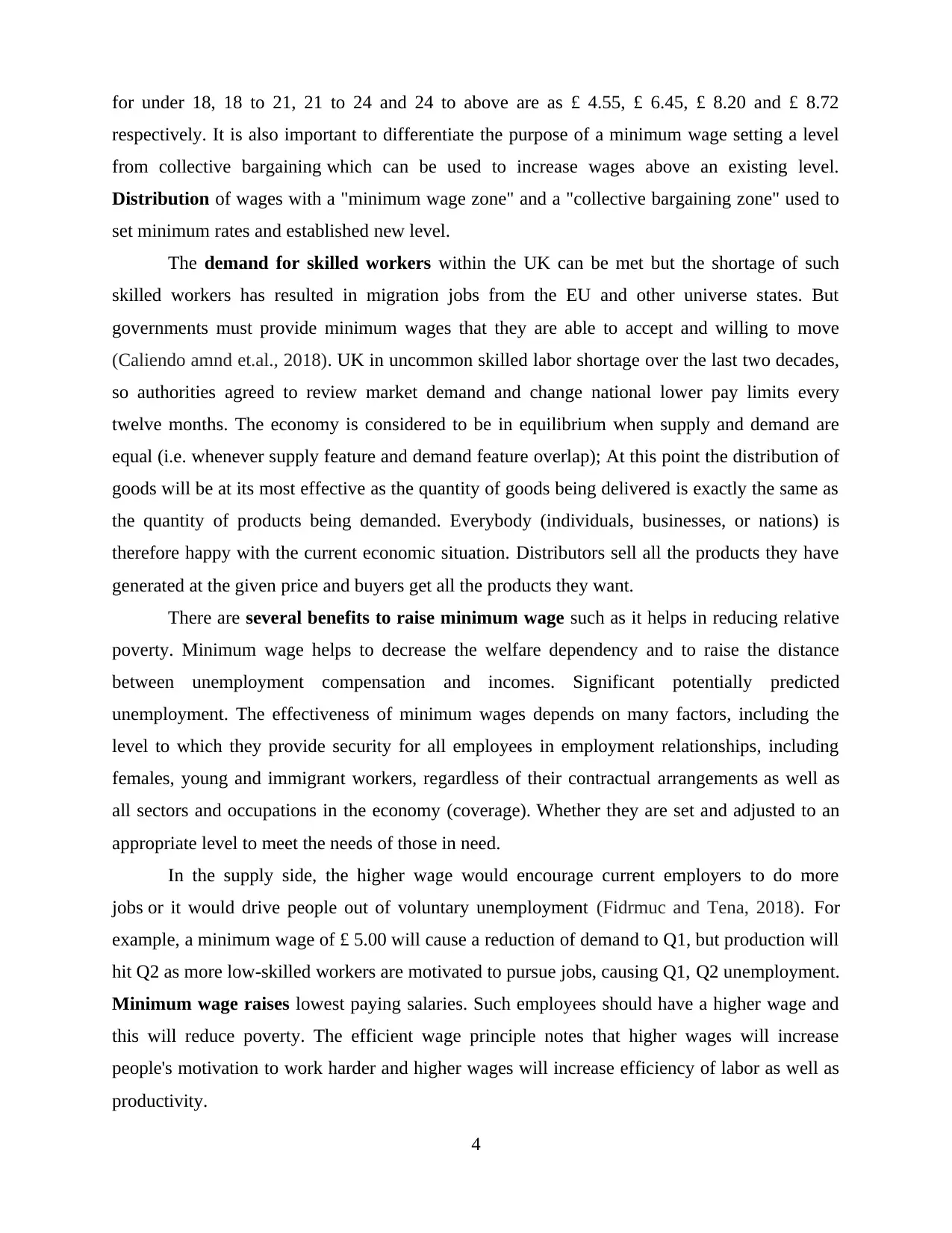
for under 18, 18 to 21, 21 to 24 and 24 to above are as £ 4.55, £ 6.45, £ 8.20 and £ 8.72
respectively. It is also important to differentiate the purpose of a minimum wage setting a level
from collective bargaining which can be used to increase wages above an existing level.
Distribution of wages with a "minimum wage zone" and a "collective bargaining zone" used to
set minimum rates and established new level.
The demand for skilled workers within the UK can be met but the shortage of such
skilled workers has resulted in migration jobs from the EU and other universe states. But
governments must provide minimum wages that they are able to accept and willing to move
(Caliendo amnd et.al., 2018). UK in uncommon skilled labor shortage over the last two decades,
so authorities agreed to review market demand and change national lower pay limits every
twelve months. The economy is considered to be in equilibrium when supply and demand are
equal (i.e. whenever supply feature and demand feature overlap); At this point the distribution of
goods will be at its most effective as the quantity of goods being delivered is exactly the same as
the quantity of products being demanded. Everybody (individuals, businesses, or nations) is
therefore happy with the current economic situation. Distributors sell all the products they have
generated at the given price and buyers get all the products they want.
There are several benefits to raise minimum wage such as it helps in reducing relative
poverty. Minimum wage helps to decrease the welfare dependency and to raise the distance
between unemployment compensation and incomes. Significant potentially predicted
unemployment. The effectiveness of minimum wages depends on many factors, including the
level to which they provide security for all employees in employment relationships, including
females, young and immigrant workers, regardless of their contractual arrangements as well as
all sectors and occupations in the economy (coverage). Whether they are set and adjusted to an
appropriate level to meet the needs of those in need.
In the supply side, the higher wage would encourage current employers to do more
jobs or it would drive people out of voluntary unemployment (Fidrmuc and Tena, 2018). For
example, a minimum wage of £ 5.00 will cause a reduction of demand to Q1, but production will
hit Q2 as more low-skilled workers are motivated to pursue jobs, causing Q1, Q2 unemployment.
Minimum wage raises lowest paying salaries. Such employees should have a higher wage and
this will reduce poverty. The efficient wage principle notes that higher wages will increase
people's motivation to work harder and higher wages will increase efficiency of labor as well as
productivity.
4
respectively. It is also important to differentiate the purpose of a minimum wage setting a level
from collective bargaining which can be used to increase wages above an existing level.
Distribution of wages with a "minimum wage zone" and a "collective bargaining zone" used to
set minimum rates and established new level.
The demand for skilled workers within the UK can be met but the shortage of such
skilled workers has resulted in migration jobs from the EU and other universe states. But
governments must provide minimum wages that they are able to accept and willing to move
(Caliendo amnd et.al., 2018). UK in uncommon skilled labor shortage over the last two decades,
so authorities agreed to review market demand and change national lower pay limits every
twelve months. The economy is considered to be in equilibrium when supply and demand are
equal (i.e. whenever supply feature and demand feature overlap); At this point the distribution of
goods will be at its most effective as the quantity of goods being delivered is exactly the same as
the quantity of products being demanded. Everybody (individuals, businesses, or nations) is
therefore happy with the current economic situation. Distributors sell all the products they have
generated at the given price and buyers get all the products they want.
There are several benefits to raise minimum wage such as it helps in reducing relative
poverty. Minimum wage helps to decrease the welfare dependency and to raise the distance
between unemployment compensation and incomes. Significant potentially predicted
unemployment. The effectiveness of minimum wages depends on many factors, including the
level to which they provide security for all employees in employment relationships, including
females, young and immigrant workers, regardless of their contractual arrangements as well as
all sectors and occupations in the economy (coverage). Whether they are set and adjusted to an
appropriate level to meet the needs of those in need.
In the supply side, the higher wage would encourage current employers to do more
jobs or it would drive people out of voluntary unemployment (Fidrmuc and Tena, 2018). For
example, a minimum wage of £ 5.00 will cause a reduction of demand to Q1, but production will
hit Q2 as more low-skilled workers are motivated to pursue jobs, causing Q1, Q2 unemployment.
Minimum wage raises lowest paying salaries. Such employees should have a higher wage and
this will reduce poverty. The efficient wage principle notes that higher wages will increase
people's motivation to work harder and higher wages will increase efficiency of labor as well as
productivity.
4
Paraphrase This Document
Need a fresh take? Get an instant paraphrase of this document with our AI Paraphraser
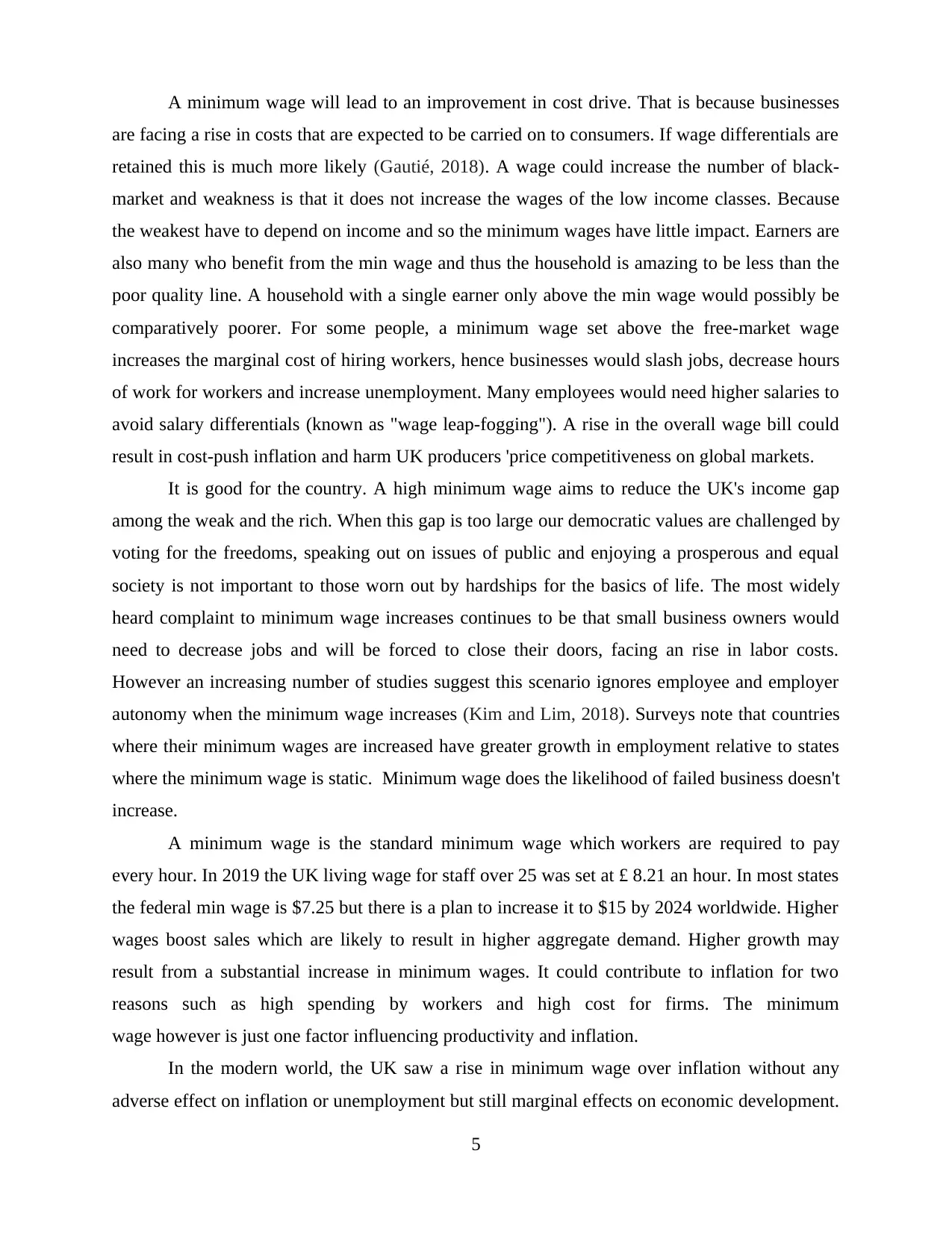
A minimum wage will lead to an improvement in cost drive. That is because businesses
are facing a rise in costs that are expected to be carried on to consumers. If wage differentials are
retained this is much more likely (Gautié, 2018). A wage could increase the number of black-
market and weakness is that it does not increase the wages of the low income classes. Because
the weakest have to depend on income and so the minimum wages have little impact. Earners are
also many who benefit from the min wage and thus the household is amazing to be less than the
poor quality line. A household with a single earner only above the min wage would possibly be
comparatively poorer. For some people, a minimum wage set above the free-market wage
increases the marginal cost of hiring workers, hence businesses would slash jobs, decrease hours
of work for workers and increase unemployment. Many employees would need higher salaries to
avoid salary differentials (known as "wage leap-fogging"). A rise in the overall wage bill could
result in cost-push inflation and harm UK producers 'price competitiveness on global markets.
It is good for the country. A high minimum wage aims to reduce the UK's income gap
among the weak and the rich. When this gap is too large our democratic values are challenged by
voting for the freedoms, speaking out on issues of public and enjoying a prosperous and equal
society is not important to those worn out by hardships for the basics of life. The most widely
heard complaint to minimum wage increases continues to be that small business owners would
need to decrease jobs and will be forced to close their doors, facing an rise in labor costs.
However an increasing number of studies suggest this scenario ignores employee and employer
autonomy when the minimum wage increases (Kim and Lim, 2018). Surveys note that countries
where their minimum wages are increased have greater growth in employment relative to states
where the minimum wage is static. Minimum wage does the likelihood of failed business doesn't
increase.
A minimum wage is the standard minimum wage which workers are required to pay
every hour. In 2019 the UK living wage for staff over 25 was set at £ 8.21 an hour. In most states
the federal min wage is $7.25 but there is a plan to increase it to $15 by 2024 worldwide. Higher
wages boost sales which are likely to result in higher aggregate demand. Higher growth may
result from a substantial increase in minimum wages. It could contribute to inflation for two
reasons such as high spending by workers and high cost for firms. The minimum
wage however is just one factor influencing productivity and inflation.
In the modern world, the UK saw a rise in minimum wage over inflation without any
adverse effect on inflation or unemployment but still marginal effects on economic development.
5
are facing a rise in costs that are expected to be carried on to consumers. If wage differentials are
retained this is much more likely (Gautié, 2018). A wage could increase the number of black-
market and weakness is that it does not increase the wages of the low income classes. Because
the weakest have to depend on income and so the minimum wages have little impact. Earners are
also many who benefit from the min wage and thus the household is amazing to be less than the
poor quality line. A household with a single earner only above the min wage would possibly be
comparatively poorer. For some people, a minimum wage set above the free-market wage
increases the marginal cost of hiring workers, hence businesses would slash jobs, decrease hours
of work for workers and increase unemployment. Many employees would need higher salaries to
avoid salary differentials (known as "wage leap-fogging"). A rise in the overall wage bill could
result in cost-push inflation and harm UK producers 'price competitiveness on global markets.
It is good for the country. A high minimum wage aims to reduce the UK's income gap
among the weak and the rich. When this gap is too large our democratic values are challenged by
voting for the freedoms, speaking out on issues of public and enjoying a prosperous and equal
society is not important to those worn out by hardships for the basics of life. The most widely
heard complaint to minimum wage increases continues to be that small business owners would
need to decrease jobs and will be forced to close their doors, facing an rise in labor costs.
However an increasing number of studies suggest this scenario ignores employee and employer
autonomy when the minimum wage increases (Kim and Lim, 2018). Surveys note that countries
where their minimum wages are increased have greater growth in employment relative to states
where the minimum wage is static. Minimum wage does the likelihood of failed business doesn't
increase.
A minimum wage is the standard minimum wage which workers are required to pay
every hour. In 2019 the UK living wage for staff over 25 was set at £ 8.21 an hour. In most states
the federal min wage is $7.25 but there is a plan to increase it to $15 by 2024 worldwide. Higher
wages boost sales which are likely to result in higher aggregate demand. Higher growth may
result from a substantial increase in minimum wages. It could contribute to inflation for two
reasons such as high spending by workers and high cost for firms. The minimum
wage however is just one factor influencing productivity and inflation.
In the modern world, the UK saw a rise in minimum wage over inflation without any
adverse effect on inflation or unemployment but still marginal effects on economic development.
5
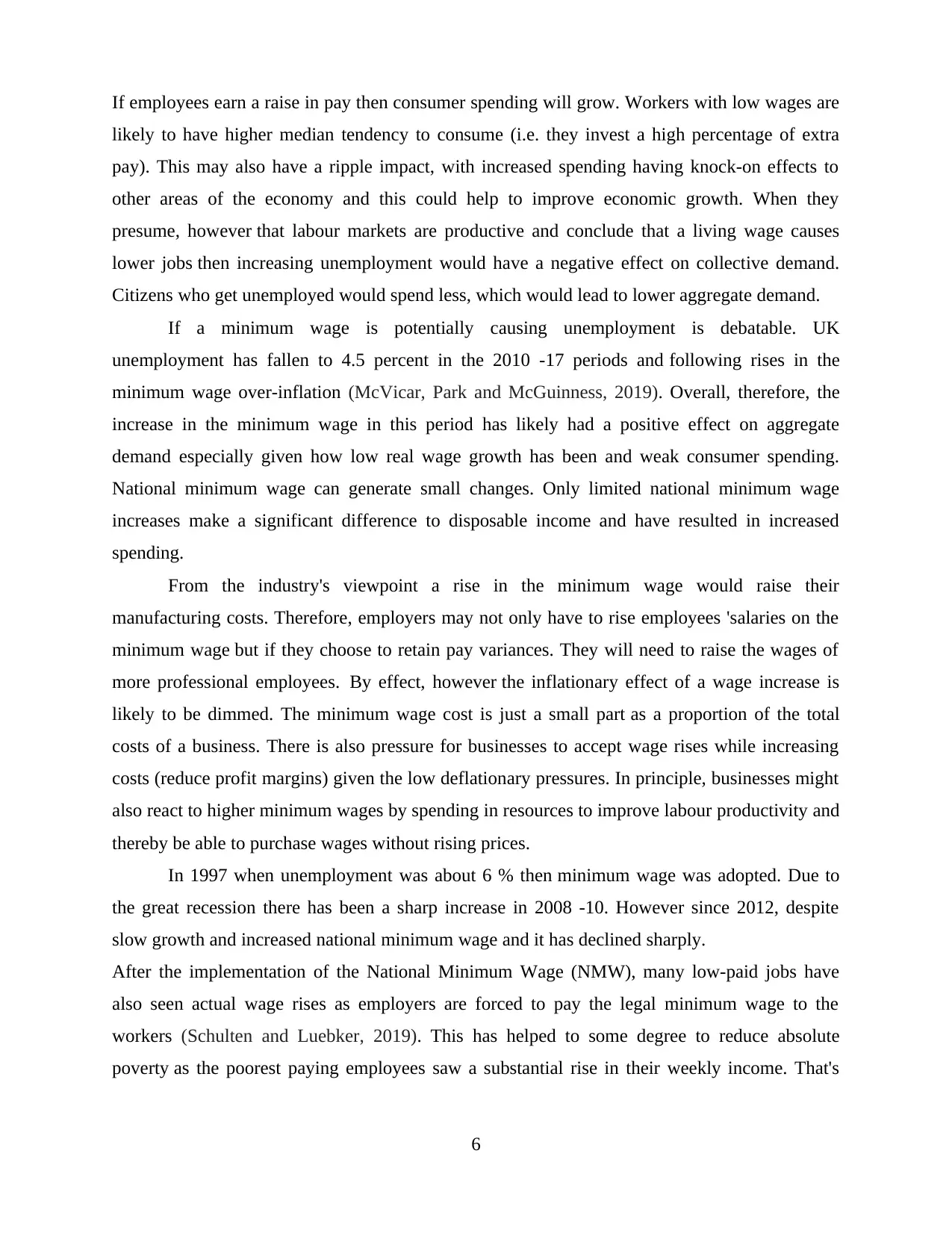
If employees earn a raise in pay then consumer spending will grow. Workers with low wages are
likely to have higher median tendency to consume (i.e. they invest a high percentage of extra
pay). This may also have a ripple impact, with increased spending having knock-on effects to
other areas of the economy and this could help to improve economic growth. When they
presume, however that labour markets are productive and conclude that a living wage causes
lower jobs then increasing unemployment would have a negative effect on collective demand.
Citizens who get unemployed would spend less, which would lead to lower aggregate demand.
If a minimum wage is potentially causing unemployment is debatable. UK
unemployment has fallen to 4.5 percent in the 2010 -17 periods and following rises in the
minimum wage over-inflation (McVicar, Park and McGuinness, 2019). Overall, therefore, the
increase in the minimum wage in this period has likely had a positive effect on aggregate
demand especially given how low real wage growth has been and weak consumer spending.
National minimum wage can generate small changes. Only limited national minimum wage
increases make a significant difference to disposable income and have resulted in increased
spending.
From the industry's viewpoint a rise in the minimum wage would raise their
manufacturing costs. Therefore, employers may not only have to rise employees 'salaries on the
minimum wage but if they choose to retain pay variances. They will need to raise the wages of
more professional employees. By effect, however the inflationary effect of a wage increase is
likely to be dimmed. The minimum wage cost is just a small part as a proportion of the total
costs of a business. There is also pressure for businesses to accept wage rises while increasing
costs (reduce profit margins) given the low deflationary pressures. In principle, businesses might
also react to higher minimum wages by spending in resources to improve labour productivity and
thereby be able to purchase wages without rising prices.
In 1997 when unemployment was about 6 % then minimum wage was adopted. Due to
the great recession there has been a sharp increase in 2008 -10. However since 2012, despite
slow growth and increased national minimum wage and it has declined sharply.
After the implementation of the National Minimum Wage (NMW), many low-paid jobs have
also seen actual wage rises as employers are forced to pay the legal minimum wage to the
workers (Schulten and Luebker, 2019). This has helped to some degree to reduce absolute
poverty as the poorest paying employees saw a substantial rise in their weekly income. That's
6
likely to have higher median tendency to consume (i.e. they invest a high percentage of extra
pay). This may also have a ripple impact, with increased spending having knock-on effects to
other areas of the economy and this could help to improve economic growth. When they
presume, however that labour markets are productive and conclude that a living wage causes
lower jobs then increasing unemployment would have a negative effect on collective demand.
Citizens who get unemployed would spend less, which would lead to lower aggregate demand.
If a minimum wage is potentially causing unemployment is debatable. UK
unemployment has fallen to 4.5 percent in the 2010 -17 periods and following rises in the
minimum wage over-inflation (McVicar, Park and McGuinness, 2019). Overall, therefore, the
increase in the minimum wage in this period has likely had a positive effect on aggregate
demand especially given how low real wage growth has been and weak consumer spending.
National minimum wage can generate small changes. Only limited national minimum wage
increases make a significant difference to disposable income and have resulted in increased
spending.
From the industry's viewpoint a rise in the minimum wage would raise their
manufacturing costs. Therefore, employers may not only have to rise employees 'salaries on the
minimum wage but if they choose to retain pay variances. They will need to raise the wages of
more professional employees. By effect, however the inflationary effect of a wage increase is
likely to be dimmed. The minimum wage cost is just a small part as a proportion of the total
costs of a business. There is also pressure for businesses to accept wage rises while increasing
costs (reduce profit margins) given the low deflationary pressures. In principle, businesses might
also react to higher minimum wages by spending in resources to improve labour productivity and
thereby be able to purchase wages without rising prices.
In 1997 when unemployment was about 6 % then minimum wage was adopted. Due to
the great recession there has been a sharp increase in 2008 -10. However since 2012, despite
slow growth and increased national minimum wage and it has declined sharply.
After the implementation of the National Minimum Wage (NMW), many low-paid jobs have
also seen actual wage rises as employers are forced to pay the legal minimum wage to the
workers (Schulten and Luebker, 2019). This has helped to some degree to reduce absolute
poverty as the poorest paying employees saw a substantial rise in their weekly income. That's
6
⊘ This is a preview!⊘
Do you want full access?
Subscribe today to unlock all pages.

Trusted by 1+ million students worldwide
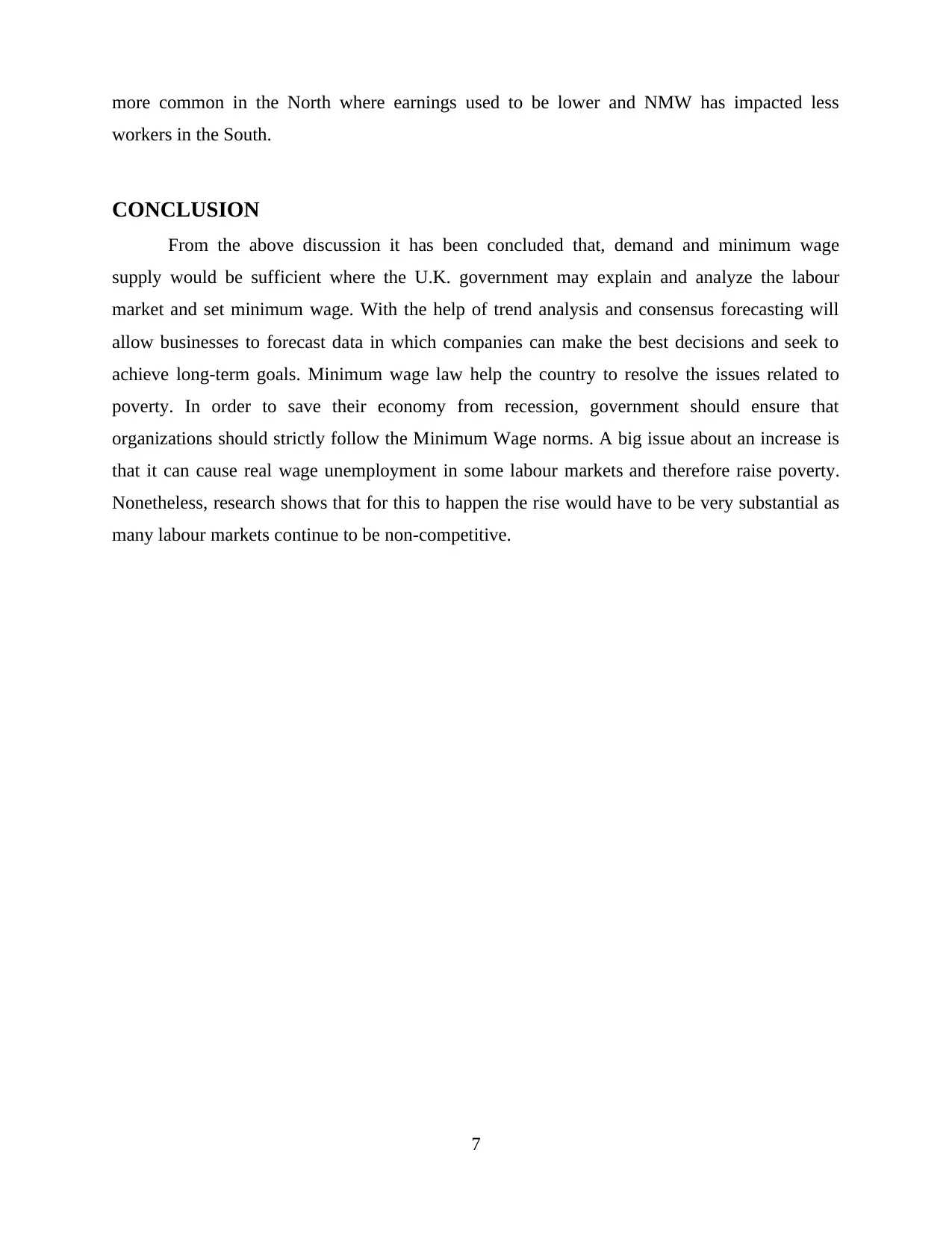
more common in the North where earnings used to be lower and NMW has impacted less
workers in the South.
CONCLUSION
From the above discussion it has been concluded that, demand and minimum wage
supply would be sufficient where the U.K. government may explain and analyze the labour
market and set minimum wage. With the help of trend analysis and consensus forecasting will
allow businesses to forecast data in which companies can make the best decisions and seek to
achieve long-term goals. Minimum wage law help the country to resolve the issues related to
poverty. In order to save their economy from recession, government should ensure that
organizations should strictly follow the Minimum Wage norms. A big issue about an increase is
that it can cause real wage unemployment in some labour markets and therefore raise poverty.
Nonetheless, research shows that for this to happen the rise would have to be very substantial as
many labour markets continue to be non-competitive.
7
workers in the South.
CONCLUSION
From the above discussion it has been concluded that, demand and minimum wage
supply would be sufficient where the U.K. government may explain and analyze the labour
market and set minimum wage. With the help of trend analysis and consensus forecasting will
allow businesses to forecast data in which companies can make the best decisions and seek to
achieve long-term goals. Minimum wage law help the country to resolve the issues related to
poverty. In order to save their economy from recession, government should ensure that
organizations should strictly follow the Minimum Wage norms. A big issue about an increase is
that it can cause real wage unemployment in some labour markets and therefore raise poverty.
Nonetheless, research shows that for this to happen the rise would have to be very substantial as
many labour markets continue to be non-competitive.
7
Paraphrase This Document
Need a fresh take? Get an instant paraphrase of this document with our AI Paraphraser
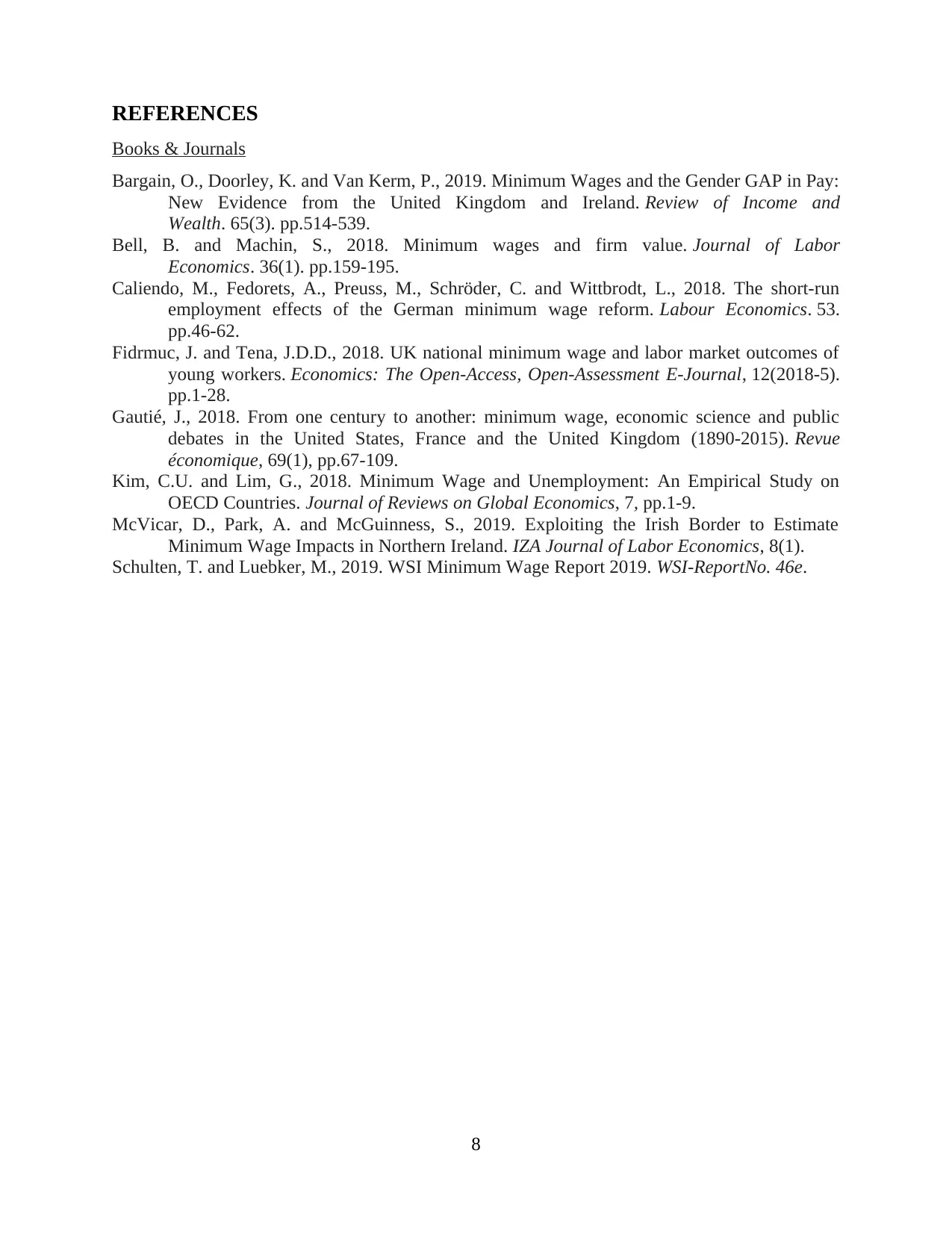
REFERENCES
Books & Journals
Bargain, O., Doorley, K. and Van Kerm, P., 2019. Minimum Wages and the Gender GAP in Pay:
New Evidence from the United Kingdom and Ireland. Review of Income and
Wealth. 65(3). pp.514-539.
Bell, B. and Machin, S., 2018. Minimum wages and firm value. Journal of Labor
Economics. 36(1). pp.159-195.
Caliendo, M., Fedorets, A., Preuss, M., Schröder, C. and Wittbrodt, L., 2018. The short-run
employment effects of the German minimum wage reform. Labour Economics. 53.
pp.46-62.
Fidrmuc, J. and Tena, J.D.D., 2018. UK national minimum wage and labor market outcomes of
young workers. Economics: The Open-Access, Open-Assessment E-Journal, 12(2018-5).
pp.1-28.
Gautié, J., 2018. From one century to another: minimum wage, economic science and public
debates in the United States, France and the United Kingdom (1890-2015). Revue
économique, 69(1), pp.67-109.
Kim, C.U. and Lim, G., 2018. Minimum Wage and Unemployment: An Empirical Study on
OECD Countries. Journal of Reviews on Global Economics, 7, pp.1-9.
McVicar, D., Park, A. and McGuinness, S., 2019. Exploiting the Irish Border to Estimate
Minimum Wage Impacts in Northern Ireland. IZA Journal of Labor Economics, 8(1).
Schulten, T. and Luebker, M., 2019. WSI Minimum Wage Report 2019. WSI-ReportNo. 46e.
8
Books & Journals
Bargain, O., Doorley, K. and Van Kerm, P., 2019. Minimum Wages and the Gender GAP in Pay:
New Evidence from the United Kingdom and Ireland. Review of Income and
Wealth. 65(3). pp.514-539.
Bell, B. and Machin, S., 2018. Minimum wages and firm value. Journal of Labor
Economics. 36(1). pp.159-195.
Caliendo, M., Fedorets, A., Preuss, M., Schröder, C. and Wittbrodt, L., 2018. The short-run
employment effects of the German minimum wage reform. Labour Economics. 53.
pp.46-62.
Fidrmuc, J. and Tena, J.D.D., 2018. UK national minimum wage and labor market outcomes of
young workers. Economics: The Open-Access, Open-Assessment E-Journal, 12(2018-5).
pp.1-28.
Gautié, J., 2018. From one century to another: minimum wage, economic science and public
debates in the United States, France and the United Kingdom (1890-2015). Revue
économique, 69(1), pp.67-109.
Kim, C.U. and Lim, G., 2018. Minimum Wage and Unemployment: An Empirical Study on
OECD Countries. Journal of Reviews on Global Economics, 7, pp.1-9.
McVicar, D., Park, A. and McGuinness, S., 2019. Exploiting the Irish Border to Estimate
Minimum Wage Impacts in Northern Ireland. IZA Journal of Labor Economics, 8(1).
Schulten, T. and Luebker, M., 2019. WSI Minimum Wage Report 2019. WSI-ReportNo. 46e.
8
1 out of 8
Related Documents
Your All-in-One AI-Powered Toolkit for Academic Success.
+13062052269
info@desklib.com
Available 24*7 on WhatsApp / Email
![[object Object]](/_next/static/media/star-bottom.7253800d.svg)
Unlock your academic potential
Copyright © 2020–2025 A2Z Services. All Rights Reserved. Developed and managed by ZUCOL.





